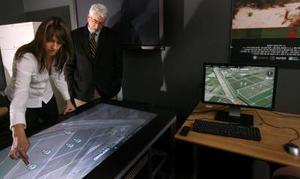Border securityMaking better decisions on border security
Researchers developed a high-fidelity simulation and analysis program that aids policy and decision-makers tasked with making key procurements and funding choices; the program is a gaming platform originally designed to prepare decision-makers and first responders for weapons of mass destruction/weapons of mass effect (WMD/WME) attacks in metropolitan areas

Researcher demonstrates Borders HLM to a visitor // Source: sciencecodex.com
With funding from the DHS’s Customs and Border Protection (CBP), researchers at Sandia National Laboratories have developed a high-fidelity simulation and analysis program that aids policy and decision-makers tasked with making key procurements and funding choices (see a brief video on this project here).
The Borders High Level Model (HLM) uses a serious gaming platform known as Ground Truth, a force-on-force battle simulation tool called Dante, and the work of several collaborating organizations.
“There’s a lot of debate going on in the government concerning the technology and infrastructure investments that need to be made along the border,” explained Jason Reinhardt, who serves as the Borders HLM project manager at Sandia. “How much fence do we need? What kind of fence? What is the right mix of border personnel and technology? How can sensors, vehicles and other technical equipment most effectively be used? With Borders HLM, CBP officials can simulate their defensive architectures, accurately measure their performance and start to answer these difficult questions.”
Ground Truth, initially funded through internal Sandia investments in 2007, is a gaming platform originally designed to prepare decision-makers and first responders for weapons of mass destruction/weapons of mass effect (WMD/WME) attacks in metropolitan areas. Developed by Sandia computer scientist and Borders HLM principal investigator Donna Djordjevich, the software provides a virtual environment where users can play through various scenarios to see the effects of their decisions under the constraints of time and resources.
For the Borders HLM project, the Ground Truth software has been integrated into a bottom-projected touch surface table. On this game surface, users can see “people” moving across the border terrain, observe CBP “personnel” responding to incidents and essentially control those movements and “apprehend” suspects. Users can also view a leader board of sorts that shows how many suspects have been apprehended, the dollar amount spent implementing the chosen architecture and other metrics that matter to CBP decision-makers.
Dante, also part of the Borders HLM platform, is a force-on-force battle simulation tool built on the well-known Umbra simulation framework developed and introduced in 2001 by Sandia researchers.
The work also builds from another Sandia borders project from the mid-2000s (focused on the impact of new detection technology at ports of entry) and capitalizes on a range of existing Sandia capabilities, including the Weapons of Mass Destruction Decision Analysis Center (WMD-DAC), the National Infrastructure Simulation and Analysis Center (NISAC, a joint
